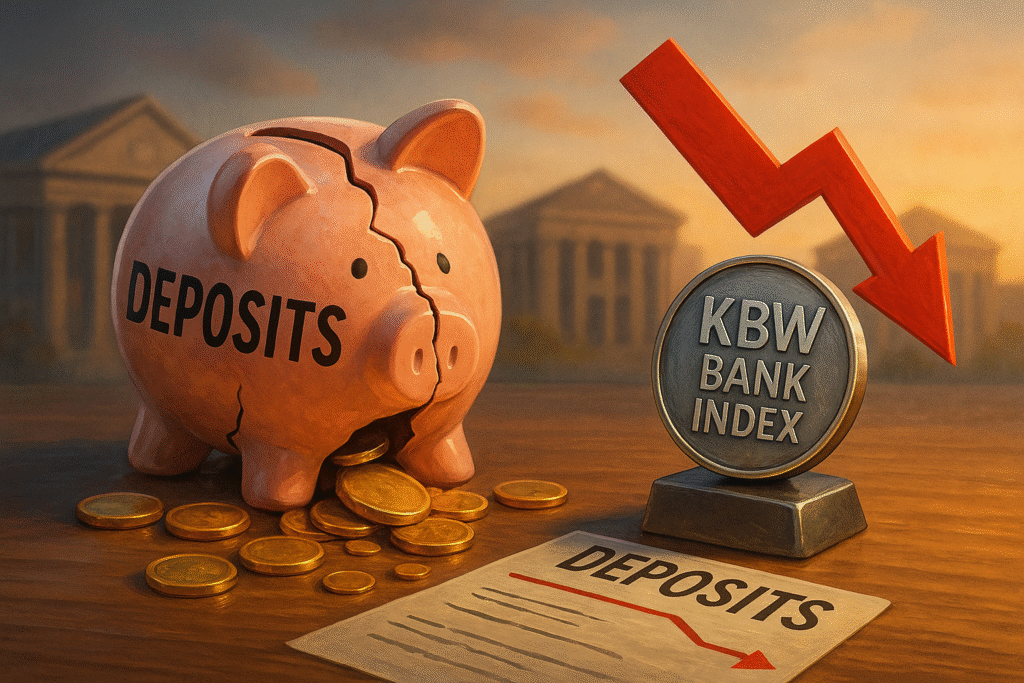Regional bank stress hit the market last week, and the KBW Bank Index fell more than six percent in five sessions. The drop came after three mid-size U.S. lenders revealed sharp deposit outflows in their first-quarter filings. Bond spreads widened, and equity investors sold bank shares. The move reminds traders that funding risk can flare even after last year’s turmoil.

Regional Bank Stress and Fresh Earnings Warnings
Two banks based in the Midwest and one in the Southeast each reported double-digit year-over-year deposit declines. The stress on these regional banks was evident as they also set aside larger loan-loss reserves. Executives blamed higher short-term rates that pushed clients toward money-market funds. These numbers re-ignited fears that the deposit flight seen in 2024 is not over. As soon as the reports hit the tape, the KBW Bank Index gapped lower at the open.
Funding Costs Rise While Loan Growth Stalls
The Federal Reserve has held its policy rate above five percent for most of 2025. Regional lenders now pay an average deposit rate of 3.4 percent, more than twice the level two years ago. Loan growth stalls as these lenders navigate regional bank stress, and net interest margins, a key profit measure, have compressed to 2.7 percent from 3.2 percent. At the same time, loan growth has slowed to a crawl. Many small businesses defer expansion plans because borrowing costs remain high. With weak top-line growth and higher funding expenses, earnings forecasts keep falling.
Credit Markets Echo Equity Weakness
Credit default swap spreads for second-tier lenders widened by fifteen basis points in the past month. In the short-term funding market, the stress of regional banks means three-month unsecured bank paper now trades 25 basis points above the secured rate, up from 18 basis points in March. This premium shows that investors demand extra compensation to hold bank debt. If spreads stay wide, banks may cut back on new lending even more, further slowing local economies.
Shareholder Response to the Regional Bank Stress
Money has moved out of bank-only exchange-traded funds. In the last two weeks, investors pulled $2.8 billion from these products, influenced by ongoing stress in regional banks. At the same time, diversified financial ETFs that hold payment firms and insurers saw small inflows. Active managers say they prefer fee-heavy businesses, which depend less on the rate curve. Some value investors, however, have begun to nibble at beaten-down regional names, betting that current prices already reflect a harsh outlook.
What Could Ease the Pressure?
Relief may come from two fronts. First, if the Fed starts cutting rates in the fourth quarter, easing the stress on regional banks, funding costs should fall. Lower deposit rates could ease margin pain. Second, commercial real-estate data have shown early signs of stabilization. Vacancy rates for suburban offices have leveled off, and rent growth in multi-family units has turned positive again. Healthier collateral values would reduce credit fears tied to property loans on regional bank books.
Risks That Could Worsen the Situation
Several threats remain. A sudden jump in Treasury yields could prompt another wave of unrealized bond losses, worsening the stress on regional banks’ capital ratios. In addition, stricter capital rules from regulators may force banks to raise fresh equity. New stock issues at depressed prices would dilute existing shareholders. Finally, more deposit movement toward the largest money-center banks could prolong the funding squeeze for smaller institutions.
Portfolio Moves in Light of Regional Bank Stress
Investors who need bank exposure can adjust size and style tilts. One approach is to stick with super-regionals that have broad funding bases and high fee income amidst regional bank stress. Another tactic is to buy preferred shares, which offer higher yields yet rank above common equity in the capital stack. Traders focused on short-term opportunities might use options to hedge downside risk while keeping upside if sentiment turns.
Outlook for the KBW Bank Index
Analysts expect the index to stay volatile until the policy path becomes clear. The consensus now sees a ten percent earnings decline for regional banks this year, followed by flat growth in 2026. Price-to-book ratios sit near historical lows, but many argue that tangible-book values could drop if credit costs rise. Any surprise improvement in deposit trends or a faster-than-expected rate cut could spark a relief rally. Until then, caution remains the watchword as regional bank stress persists.
The stress in regional banks will continue to guide sentiment toward the entire financial sector. By tracking deposit data, funding spreads, and policy signals, investors can gauge when the tide may turn for smaller lenders and, by extension, the KBW Bank Index.